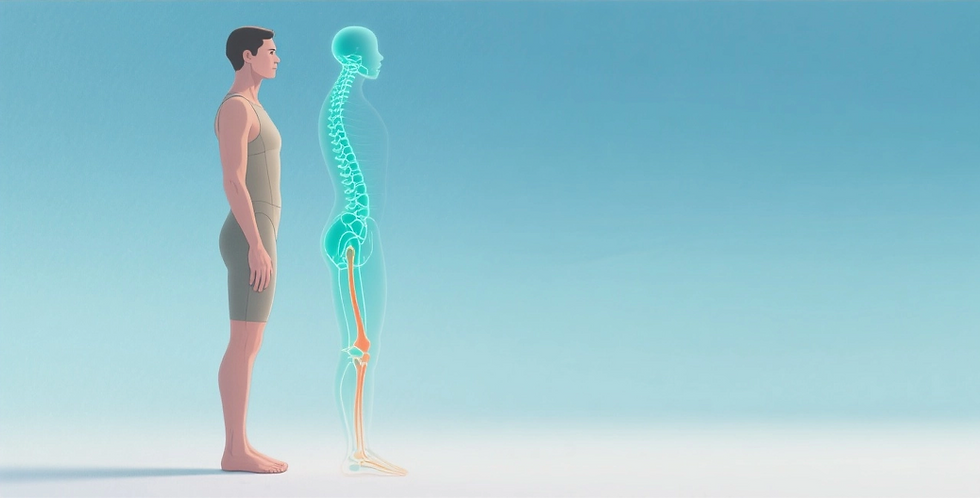Why Tight Hamstrings Could Be the Root Cause of Your Neck Pain
- Luc

- Aug 14
- 3 min read
The Posterior Chain and Its Role in Movement

The posterior chain refers to a group of interconnected muscles, fascia, and tendons that run along the back of the body, from the base of the skull to the soles of the feet. This chain includes muscles such as the hamstrings, glutes, spinal erectors, and neck extensors. These muscles work together to maintain posture, facilitate movement, and provide stability.
When one part of the posterior chain becomes tight or dysfunctional, it can create a ripple effect throughout the chain, leading to compensations and imbalances in other areas. This is the basis for how tight hamstrings can influence the neck.
How Tight Hamstrings Affect the Pelvis and Spine
Posterior Pelvic Tilt:
Tight hamstrings can pull the pelvis into a posterior tilt (where the back of the pelvis rotates downward and the front tilts upward).
This pelvic misalignment alters the natural curvature of the spine, particularly the lumbar (lower back) region, which can flatten or reduce the lumbar lordosis (the natural inward curve of the lower back).
Impact on the Spine and Neck:
The spine is a connected structure, so changes in the lower back can affect the upper back and neck. A posterior pelvic tilt can lead to compensatory changes in the thoracic spine (mid-back) and cervical spine (neck).
To maintain balance and keep the head upright, the neck extensors (muscles at the back of the neck) may become overactive and tight, while the neck flexors (muscles at the front of the neck) become underactive or inhibited.
Neck Extensors and Flexors: The Imbalance
Overactive Neck Extensors:
When the hamstrings and posterior chain pull the pelvis and spine out of alignment, the neck extensors (e.g., suboccipital muscles, splenius capitis, and semispinalis capitis) are forced to work harder to hold the head in position.
This overactivity can lead to tightness, discomfort, and even chronic pain in the neck.
Inhibited Neck Flexors:
The deep neck flexors (e.g., longus colli and longus capitis) are responsible for stabilizing and flexing the neck. However, when the neck extensors are overactive, the flexors can become "turned off" or underactive due to reciprocal inhibition (a neurological phenomenon where the activation of one muscle group inhibits its opposing group).
This imbalance further contributes to poor posture and neck pain.
Testing with PDT-R
PDT-R (Proprioceptive Deep Tendon Reflex) is a method used to assess muscle function and imbalances. When testing individuals with neck pain, practitioners often find:
Overworking Hamstrings: The hamstrings may compensate for other weak or inhibited muscles in the posterior chain, leading to their overactivation.
Underworking Neck Flexors: The deep neck flexors are often found to be weak or inhibited, which aligns with the biomechanical chain reaction caused by tight hamstrings.
The Role of the Hamstrings in Neck Pain
The hamstrings play a critical role in maintaining pelvic alignment and, by extension, spinal alignment. When they are tight or overactive:
They disrupt the alignment of the pelvis and spine.
This misalignment places additional strain on the neck extensors, leading to tightness and pain.
The resulting imbalance between the neck extensors and flexors perpetuates poor posture and discomfort.
Addressing tight hamstrings through stretching, strengthening, and releasing tension can help restore proper pelvic and spinal alignment, reducing strain on the neck and alleviating pain.
Conclusion
The connection between tight hamstrings and neck pain highlights the importance of viewing the body as an interconnected system. Dysfunction in one area, such as the hamstrings, can have far-reaching effects on other areas, like the neck, through the posterior chain. By addressing the root cause (e.g., tight hamstrings), practitioners can help alleviate neck pain and restore balance to the entire kinetic chain.
This article emphasizes the need to consider the role of the hamstrings in neck pain and provides a framework for understanding how the posterior chain influences posture and muscle function.





Comments